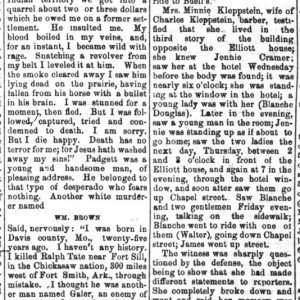calsfoundation@cals.org
Manley Brothers (Execution of)
On September 9, 1881, Amos Manley and Abler Manley (sometimes referred to as Abner), eighteen- and twenty-year-old Creek brothers, were hanged in Fort Smith (Sebastian County) for the murder of farmer Ellis McVay (sometimes identified as Eli McVay or Ellis McVeigh).
The September 9, 1881, edition of the Arkansas Democrat gives an account of the crime, which it called “one of the bloodthirstiest pages in the criminal annals.” On December 3, 1880, the Manleys stopped at McVay’s farm near Eufala on the Choctaw/Creek border on their way to the Choctaw Nation. According to the Democrat, the Manleys were out hunting on the snow-covered prairie when they got lost. Hungry, cold, and exhausted, they came upon the cabin of a white man named McVeigh (as it was spelled in the Democrat article). McVeigh took them in and gave them food. Everyone, including McVeigh’s hired man Barrett (other sources identify him as Barnett or William Burnett), went to bed. Around midnight, McVeigh got up to comfort one of his children, who was sick. One of the Manley brothers got up and shot McVeigh fatally through the heart; the child was not injured. The other brother hit Barrett over the head with an axe and then cut off his left hand and tried to remove one of his legs. Before they could murder McVeigh’s wife and her young twins, the family dog began to bark; the Manleys, fearing that someone was approaching, ran away. Mrs. McVeigh ran with her children to the home of a neighbor, two miles away, where she collapsed in the snow. They took her in, and at daylight Barrett (who had been left for dead) appeared, having crawled the entire two miles. The neighbors cared for them and notified the authorities. The Manley brothers were captured the next day.
Another report stated that, according to Mrs. McVay, the brothers were supposedly on their way to a Mrs. Sweet’s land to pick cotton. After going to bed, they got up and stood by the fire, “laughing and talking in the Creek language.” Mr. McVay, who was sitting up with a sick child, gave one of them some tobacco, and they then stood by the fire and smoked. After some time, they fired at Mr. McVay, who was unarmed, with a six shooter and a pocket pistol. He immediately fell. Bill Barnett jumped from bed and was shot; Mrs. McVay got up, and they shot at her but missed. Barnett struggled with one brother, but the other struck him with the axe. As described above, the dog began to bark, and the Manleys fled.
The Manley brothers were tried twice. They were not convicted at their first trial because one of the jurors was opposed to capital punishment. Their second trial was held in June 1881 before Judge Isaac Parker. On June 16, they were sentenced to be hanged. They, along with the three men sentenced with them for other crimes, appealed, but on September 5 their appeal was denied.
The execution took place on the morning of September 9, 1881. Based on a dispatch from Fort Smith, the September 10 edition of the Chicago Tribune published the details of the hanging. Unlike other executions at Fort Smith, this one was held in an enclosure in the corner of the old military fort, and only forty spectators were admitted. According to the Tribune, “A guard was set on the walls surrounding the fort to keep back the people who surrounded it and clamored for admittance.” The prisoners exited the prison at 10 a.m., after which the death warrants were read and each was allowed to speak. All of them confessed their guilt, and the Manleys, having been received into the Methodist Church, expressed their penitence. They accepted their fate and said that they were not afraid to die. The trap was sprung, and the bodies fell. Three of the men died instantly, but the Manley brothers “perished miserably.” Amos Manley’s heart did not stop for fifteen minutes. The bodies were then cut down. In closing, the Tribune opined: “Everyone present admitted he had never seen an execution more orderly, but it was a horrible spectacle, which all hope never to witness again.”
For additional information:
Akins, Jerry. “Hangin’ Times in Fort Smith.” Journal of the Fort Smith Historical Society 27 (September 2003): 9–17. Online at https://uafslibrary.com/fshsj/27-02_Complete_Issue.pdf (accessed February 20, 2024).
“Amos and Abel Manley.” Chicago Daily Tribune, September 10, 1881, p. 10.
“Fitted to Five.” Arkansas Democrat, September 9, 1881, p. 1.
Nancy Snell Griffith
Davidson, North Carolina
 Law
Law Post-Reconstruction through the Gilded Age, 1875 through 1900
Post-Reconstruction through the Gilded Age, 1875 through 1900 William Barnett and Family
William Barnett and Family  Manley Brothers Execution Article
Manley Brothers Execution Article 



Comments
No comments on this entry yet.